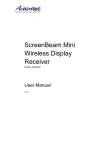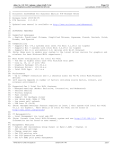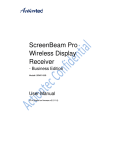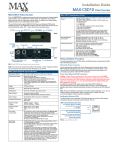Download Actiontec ScreenBeam Pro
Transcript
4DSFFO#FBN1SP Model #: 4#8%" User Manual Ver 1.0 Solutions for the Digital Life™ Table of Contents Getting Started 3 Introduction 3 Package Contents 3 System Requirements 3 Installing the Receiver 5 Connecting the Receiver to an HDTV 5 Setting Up for the First Time 7 Connecting Via Intel WiDi App 7 Connecting Via Windows 8.1+ 10 Connecting Via Miracast™ 12 Tips for Optimal Performance 12 Display and Control Options 13 Display Mode 13 Ultra-Low Delay 14 USB over Network 15 1 ScreenBeam Pro Wireless Display Receiver Restore to Default 15 Troubleshooting and FAQs 16 Troubleshooting Issues 16 Frequently Asked Questions 18 Specifications 20 Notices 22 Warranty 22 GPL Info 22 EU CE Declaration of Conformity 23 Technical Support 23 2 Getting Started Introduction Congratulations on your purchase of a ScreenBeam Pro Wireless Display Receiver. The Receiver lets you wirelessly transmit what’s on your compatible Intel WiDi, Windows 8.1+, or Miracast™ wireless displaycapable device, and displays it on your HDTV. This user manual will take you through the procedures needed to connect, configure, and operate the Receiver, and also describe a few different possible scenarios concerning setup locations. Package Contents • ScreenBeam Pro Wireless Display Receiver (1) • Power Adapter (1) • HDMI® Cable (1) • Product documentation System Requirements Receiver To connect the Receiver, you must have the following items: • An HDTV monitor with one free HDMI port • An available power outlet 3 ScreenBeam Pro Wireless Display Receiver Compatible Devices The Receiver connects with devices that run one of the following operating systems: • 4th Gen Ultrabook with Intel WiDi 4.x • Laptop or notebook with Intel WiDi 3.5 or higher • Smartphone, tablet, or laptop running Windows 8.1 or higher • Miracast™-enabled Android device 4 Installing the Receiver This chapter explains how to connect the ScreenBeam Pro Wireless Display Receiver to an HDTV monitor. Make sure you have all the contents from the Receiver’s package available before starting. Connecting the Receiver to an HDTV To connect the Receiver to an HDTV monitor: 1. Get the Receiver, power cord, and HDMI cable from the ScreenBeam Pro package. 2. Plug one end of the supplied HDMI cable into the HDMI port on the Receiver, and the other end into an available HDMI port on the HDTV. 3. Plug one end of the power cord into the Receiver, and the other end into a power outlet. When Steps 1, 2, and 3 are complete, the hardware should be connected as shown in the figure, below. Note: The power outlet and cable may appear different than those shown in the figure. 5 ScreenBeam Pro Wireless Display Receiver 4. Make sure the HDTV is turned on and set to display the input from the correct HDMI port (the one you plugged into during Step 2). 5. Verify that the “Ready to Connect” screen appears on the HDTV. The Receiver is connected to the HDTV, and ready to be configured. 6 Setting Up for the First Time This chapter explains how to connect ScreenBeam Pro Wireless Display Receiver for the first time to the source device. There are three source device options: Intel WiDi, Windows 8.1+, or Miracast™. Connecting Via Intel WiDi App This section explains how to connect a device running Intel’s WiDi application to the Receiver. Note: If the device’s operating system is Windows 8.1 or higher, go to the next section in this manual (“Connecting Via Windows 8.1+”) for connection instructions. 7 ScreenBeam Pro Wireless Display Receiver 1. Launch the Intel Wireless Display Application on the device. To find the application, go to Windows Search on the device and search for “Intel WiDi.” 2. The device scans for available receivers. Select the same receiver name as seen on the HDTV and click Connect. (The “Connect Automatically” checkbox is optional.) 3. Wait until the Receiver displays a PIN on the HDTV, and a PIN entry box on the screen of the WiDi device. Enter the PIN in the PIN entry box on the WiDi device, then click Continue. 8 Setting Up for the First Time 4. The HDTV displays messages to show the status of the connection process. 5. A “Connection Successful” screen appears on the device’s screen, as well as on the HDTV. Adjusting the HDTV Picture If the edges of the device screen cannot be seen on the HDTV, adjust cropping. To do this, enter the WiDi application and click Settings. Navigate to the “Picture and Sound” section, select Adjust cropping…, and adjust the HDTV picture by clicking plus (+) or minus (-). 9 ScreenBeam Pro Wireless Display Receiver WiDi Software Version Support Make sure the device supports Intel Wireless Display (WiDi) software version 3.5 or higher. To find out which version of Intel WiDi the device is running, enter the Intel WiDi application and click Help, then navigate to the “About WiDi” section. To obtain the latest Intel WiDi software and drivers, go to: http://www.intel.com/go/wirelessdisplayupdate. Connecting Via Windows 8.1+ This section explains how to connect a device running Windows 8.1 or higher to the Receiver. 1. From the Windows desktop, go to the “Charms” menu and select Devices. You can also use the shortcut keys, Windows logo + K. 2. From the “Charms” menu, click Project. 10 Setting Up for the First Time 3. From the “Project” screen, select Add a wireless display. 4. Select the appropriate Receiver from the list. 5. Enter the PIN as displayed on the television screen, then connect and display. Click Next to continue. 11 ScreenBeam Pro Wireless Display Receiver Connecting Via Miracast™ This section explains how to connect the Receiver to a Miracast™-enabled Android device, such as a smartphone, tablet, or game console. For best performance, the Miracast™ device should be running the latest software. 1. On a Miracast™-enabled Android device, locate and open the Wireless Display Application (check for the application under “Settings”). Note: The name of the Wireless Display Application depends on the device type and model. Refer to the device’s carrier or manufacturer user manual for more details. 2. The Wireless Display Application scans for available receivers. Select the Receiver from the list. 3. Wait for the device to associate with the Receiver. When it does, the device’s screen will be displayed on the HDTV. Tips for Optimal Performance • Keep the Receiver within line-of-sight of the source device. Doing this will help ensure the HDTV receives the best possible signal. • The Receiver’s optimal wireless range is within 30 feet of the source device. However, actual range and effectiveness depends on many factors, including other sources of interference and the building materials used in the surrounding structure. 12 Display and Control Options This chapter describes the various display options offered by different manufacturers and operating systems that are supported by the ScreenBeam Pro Wireless Display Receiver. Display Mode The Receiver supports three display modes when connected with a compatible wireless display application (Intel WiDi or Windows 8.1 Project, for example). In Windows, select Display mode by pressing the Windows logo + P keys simultaneously and selecting the appropriate mode from the “Options” menu. Duplicate Duplicate mode is used to display the same content on both the device’s screen and the HDTV simultaneously. Note: There may be a minor delay between the display showing on the HDTV screen compared to the device screen. This is due to the current state of wireless display technology. Extend Extend mode creates a single, extended “screen” between the source device and the HDTV. When in Extend mode, dragging windows to right side of the device’s screen displays those windows on the HDTV, while dragging windows to the left of the HDTV screen displays them back on the device’s screen. This mode allows users to display selected content on the HDTV, while all other windows remain on the device’s screen. When this mode is first selected, the HDTV displays only the Windows desktop. 13 ScreenBeam Pro Wireless Display Receiver Second Screen Only Second Screen Only mode causes the HDTV to be the only display for the device. In this mode, the device’s screen will be blank. Ultra-Low Delay The Receiver also supports Ultra-Low Delay mode, which helps reduce end-to-end wireless display latency. Real-time applications, such as games, can run without noticeable delay when Ultra-Low Delay mode is enabled on supported devices. Intel WiDi 4.0 and higher To activate Ultra-Low Delay on a device running Intel WiDi 4.0 or higher: 1. Launch the Intel WiDi application, then select Settings. 2. From the “Settings” screen, select Current Wireless Display. 3. Select Prioritize Speed from the “Quality vs. Speed” menu. Refer to Intel’s support documentation for more information. NVidia Shield 1. Go to “Settings,” then select Miracast™. 2. Tap on the toggle switch to turn “Game Mode” on. Note: The output resolution will reset to 720P once this mode is enabled. Refer to the device’s user manual for more information. 14 Display and Control Options USB over Network The Receiver’s USB over Network (UoIP) feature allows the use of USB HID peripheral devices, either from the source device or from the USB device side. To connect a USB keyboard, mouse, or trackpad: 1. Plug the device into the Receiver’s USB port and wait for the device to be detected. This may take 10-15 seconds. 2. Use the USB keyboard, mouse, or trackpad to control the device. Restore to Default To restore the Receiver’s default factory settings: 1. After the Receiver is powered on, wait until the “Ready to Connect” screen is displayed on the HDTV. 2. Hold down the Receiver’s “Reset” button. 3. When the “Restore to Default” screen appears on the HDTV, release the “Reset” button. When the Receiver reboots, it will be running with its default settings. 15 Troubleshooting and FAQs This chapter describes some problems you may encounter using the ScreenBeam Wireless Display Receiver, and possible solutions to those problems. Also included are frequently asked questions, and answers to those questions. Troubleshooting Issues I'm not seeing anything on my HDTV screen after powering on the Receiver. Check the cable connections and make sure the TV Input setting is the same as the HDMI port to which the Receiver is connected. When I connect to an access point or wireless router with an active WiDi session, the WiDi connection drops. This a known issue with Intel WiDi. To solve the problem, connect the Intel WiDi PC to an access point or wireless router before starting a WiDi session. In some instances, I can’t connect to the Receiver from WiDi after installing antivirus software. This is also a known issue with Intel WiDi. To solve the problem, add Intel WiDi to the antivirus-approved whitelist of applications, then reconnect. 16 Troubleshooting and FAQs I’m seeing artifacts and experiencing a choppy, juddering video stream. In noisy WiFi environments, audio and video freezes may be observed while playing video content, and longer than expected latency may occur when streaming. To ensure you have an optimal WiFi environment: • Disconnect and reconnect the Receiver. • If the source device is connected to a wireless router, change the operating channel on the router. Refer to the wireless router’s user manual for more information. I'm seeing choppiness and brief pauses while watching Internet video on my Miracast™ device. Wireless interference may cause Internet video playback to be choppy. If this occurs, try the following; • Disconnect the device from the Receiver. Make sure the Internet connection is good and that the video playing on the phone is smooth. • Clear the YouTube cache and try playing the video again. I'm seeing choppiness and brief pauses while watching local video on my Miracast™ device. Wireless interference may cause the video playback to be choppy. If this occurs, try the following: • Make sure you are in the same room as the Receiver. • Set the media player to use the H/W decoder, if available. • Reboot the Miracast™ device and Receiver and connect again. • Avoid moving the Miracast™ device around too much. 17 ScreenBeam Pro Wireless Display Receiver Frequently Asked Questions How can I adjust the display to fit properly to my TV screen? Launch the Intel WiDi application, then select Settings, then Picture and Sound, then Adjust Cropping. Follow the onscreen instructions to adjust the picture. Where can I obtain the latest Intel WiDi application and graphic drivers for my Intel WiDi device? To obtain the latest Intel WiDi software and drivers, go to http://www.intel.com/go/wirelessdisplayupdate Can I connect to the WiFi router and the Receiver simultaneously with my Intel WiDi laptop? Yes. Connect the laptop to an available WiFi router first, and then connect to the Receiver. You can then view online content and beam it to the HDTV. Can I connect to the WiFi router and the Receiver simultaneously with my Miracast™ device? Some Miracast™ devices cannot connect to both WiFi router and the Receiver at the same time. Refer to the device manufacturer's or carrier's user manual for more information. What is Wi-Fi Miracast™? Wi-Fi Certified Miracast™ is a groundbreaking solution for seamlessly displaying video between devices, without cables or a network connection. Users can view pictures from a smartphone on a big screen television, share a laptop screen with the conference room projector in real-time, and watch live programs from a home cable box on a tablet. Miracast™ connections are formed using Wi-Fi Certified Wi-Fi Direct™, so access to a Wi-Fi® network is not needed–the ability to connect is inside Miracast™-certified devices. 18 Troubleshooting and FAQs What is Wi-Fi Direct and can I connect to the Receiver using Wi-Fi Direct? Wi-Fi Direct is a peer-to-peer technology that Miracast™ connections are formed in. Even though some newer Android 4.0 and Windows 8.1 devices may pick up the Receiver in the Wi-Fi Direct devices scan list, they will not be able to connect to the Receiver. The device must support Miracast™ to connect with the Receiver. Do I need an existing wireless network to use the Receiver? No. Since the Receiver connects directly with the Intel WiDi or Miracast™-enabled device, no wireless network is needed. However, the source device needs to be connected to an Internet router or data network to view online content. What wireless signal range can I expect with the Receiver? The Receiver is designed to be used in the same room with the source device. Can I push media to the Receiver using DLNA? No. The the Receiver is not a DLNA media receiver. Does the Receiver work with the Apple iPhone, iPad, or iPod? No. The Receiver does not support Apple devices or the AirPlay protocol. For additional frequently asked questions, go to http://international.actiontec.com/support. 19 Specifications Model Number SBWD100A Certifications Intel WiDi Wi-Fi Certified Miracast™ HDMI HDCP Wireless Wi-Fi 802.11 IEEE standard 5GHz/2.4GHz Wi-Fi Direct WMM Access Methods PIN Virtual PBC pairing LED Indicators Power Environmental 20 ScreenBeam Pro Wireless Display Receiver Power External, 110 - 240v 2 A, 50 - 60 Hz Regulatory FCC part 15, IC, UL, CE, C-Tick, TELEC, KCC, RoHS, EAC, and SRRC Environmental Operating temperature - 0º C to 40º C (32ºF to 104ºF) Storage temperature - 0ºC to 70ºC (32ºF to 158ºF) Operating humidity - 10% to 85% non-condensing Storage humidity - 5% to 90% non-condensing Note: Specifications are subject to change without notice. 21 Notices Warranty This product has a one-year Limited Hardware Warranty and 90-day free software updates from date of purchase. Local Law This Limited Warranty Statement gives the customer specific legal rights. The customer may also have other rights which vary from state to state in the United States, from province to province in Canada, and from country to country elsewhere in the world. To the extent that this Limited Warranty Statement is inconsistent with local law, this Statement shall be deemed modified to be consistent with such local law. Under such local law, certain disclaimers and limitations of this Warranty Statement may not apply to the customer. Go to http://www.actiontec.com/products/warranty.php for more information. GPL Info For GNU General Public License (GPL) related information, go to http:// opensource.actiontec.com 22 Notices EU CE Declaration of Conformity To obtain the complete Declaration of Conformity form in softcopy, go to the Actiontec Electronics Declarations of Conformity EU/EEA website at http://international.actiontec.com/support/doc The symbol below is placed in accordance with the European Union Directive 2002/96 on the Waste Electrical and Electronic Equipment (the WEEE Directive). If disposed of within the European Union, this product should be treated and recycled in accordance with the laws of your jurisdiction implementing the WEEE Directive. Technical Support Go to http://international.actiontec.com/support for product support, updates, and more information including: • Firmware updates • Troubleshooting • Registration • FAQs Technical Support Phone Number United States: 1-888-436-0657 23







































